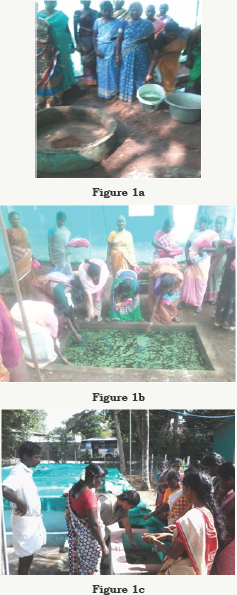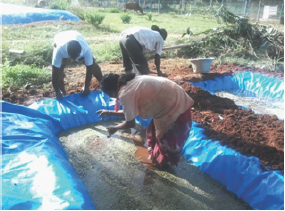- Submissions

Full Text
Approaches in Poultry, Dairy & Veterinary Sciences
Azolla Cultivation in Generating Income for Farm Women
Gayathri Subbiah1* and Vimalarani M2
1Plant Pathology, Tamil Nadu Veterinary and Animal Sciences University, India
2Department of Home Science, ICAR-Krishi Vigyan Kendra, India
*Corresponding author: Gayathri Subbiah, Plant Pathology, Tamil Nadu Veterinary and Animal Sciences University, Chennai, Tamil Nadu, India
Submission: August 31, 2017; Published: November 13, 2017

ISSN : 2576-9162Volume1 Issue5
Abstract
During the last few decades rural women are engaged in agricultural activities like seed sowing, intercultural operations, harvesting, storage of grains and care and management of livestock and poultry. Women encounter drudgery in various works and spend more time in farm work than on household activities. In order to generate income for farm women and to reduce the amount spent on livestock feed and also to improve their livelihood, training on Azolla cultivation was conducted at Krishi Vigyan Kendra, Kattupakkam, Kancheepuram district of Tamil Nadu, India. Azolla is an aquatic fern having symbiotic relationship with bacteria Anabena Azollae, which fixes the atmospheric nitrogen. Method demonstrations were conducted on various ways of production. Based on the facilities available in their place, the trained women cultivated Azolla (viz., Pit size of 7X3ft and 7" depth) and used it as feed for their livestock. Nearly about 2-3kg of Azolla was harvested from each pit. Azolla as a source of livestock feed reduced the feeding cost which was spent for purchasing the feeding materials for poultry, goat and dairy cattle. By feeding of Azolla to dairy cattle, milk quality and yield has increased (100-150ml per day per animal) considerably. The Azolla produced in excess was sold at the rate of Rs. 10/kg to the other farmers as Azolla culture as well as feed for other cattles.
Abbreviations: Farm women; Azolla; Livestock feed
Introduction
In order to uplift the poor socio-economic conditions of the farm women by raising the level of farm productivity, income and employment with application of agricultural technologies generated at research institutes, trainings are being conducted at ICAR-Krishi Vigyan Kendra (KVK), Kattupakkam. Women are employed for various farm activities like seed sowing, transplanting, harvesting and maintenance of livestock and poultry. During these operations, women face lot of problems related to health and also time consumed for farm work is more than their normal activities. Livestock management forms an integrated system for livelihood for women in agriculture. Dairy farming is one of the important activities where women spend lot of time for managing the animal, feeding and milking. Amount spent for feeding the animal at present cost nearly Rs. 50-60/animal/day yielding 3-4 liters of milk/day along with green fodder feed @ 15kg/day.
In order to reduce the cost on feed and also to improve the economic condition of the farm women and generate income Azolla cultivation training was given. The present paper brings out the importance of Azolla cultivation and income generated by the farm women through its cultivation. Azolla is water fern, having symbiotic relationship with bacteria Anabena Azollae. Azolla has very fast growing character. It doubles its biomass in 3-5 days. Extensively used as biofertilizer and green manuring for rice cultivation. The ideal condition for growth is at Temperature 20 °C-28 °C with Light 50% full sunlight, Relative Humidity 65-80%, Water (in standing condition) 5-12cm and pH 4-7.5. Azolla is very rich in proteins, essential amino acids, vitamins (vitamin A, vitamin B12, Beta Carotene), growth promoter intermediaries and minerals including calcium, phosphorous, potassium, ferrous, copper, magnesium. On a dry weight basis, Azolla has 25-35% protein content, 10-15% mineral content, and 7-10% comprising a combination of amino acids, bio-active substances and biopolymers [1].
Methods and Materials
Azolla cultivation training was given at ICAR-Krishi Vigyan Kendra (KVK), Kattupakkam where in women engaged in agricultural works under went training programmers. Method demonstration of different ways of cultivation such as pit method, silpauline sheet method, and cultivation in tubs, were demonstrated. Based on the available land area, the trained women cultivated Azolla in their farm for the purpose of feeding their dairy cattle.
The soil in the selected area was cleared of weeds and leveled. Bricks were lined horizontally in a rectangular fashion. Silpauline sheet of 2mX2m size was uniformly spread over the bricks in such a way as to cover the margin of the rectangle made by the bricks. Ten to fifteen kg of sieved soil was uniformly spread over the silpauline pit. Slurry made of 2kg cow dung in 10 liters of water, was poured onto the sheet. More water was poured on to raise the level to about 10cm. About 0.5-1kg of pure mother Azolla culture seed material was spread uniformly over the water, after mild stirring of soil and water in the Azolla bed so as to distribute the nutrients uniformly for the growth of the Azolla. Fresh water was sprinkled over the Azolla immediately after inoculation to make the Azolla plants upright. In a week's time, the Azolla was developed all over the bed and formed a thick mat like appearance. Cow dung slurry was applied once in 5 days in order to maintain rapid multiplication of the Azolla and to maintain the daily yield of 500g. Once every 10 days, 25 to 30 percent of the water was replaced with fresh water, to prevent nitrogen build up in the bed. The bed was cleaned, the water and soil replaced and new Azolla inoculated once every two months (Figure 1 & 2) [2].
Figure 1(a,b,c): Azolla cultivation in Cement tanks.

Figure 2: Azolla cultivation in silpauline sheet.

Results and Discussion
Azolla grows well in pit within 10-15 days. From then on, 500-600g of azolla was harvested daily. From the 15th day onwards with the help of a plastic sieve or tray with holes at the bottom, Azolla was harvested every day. The harvested Azolla washed in fresh water to get rid of the cow dung smell. Then used as feed for the dairy cattle. By using Azolla as a feed, it was found that there was an increase in milk yield of 100-150ml/animal/day. This also reduced the cost of spent on the purchase of feed materials purchased. Azolla use nearly supplemented 30% of protein requirement [3].
The Azolla produced in excess was sold at the rate of Rs. 10/kg to the other farmers as Azolla culture as well as feed for other cattle. By using Azolla, Farm women encountered increased milk yield and also were free of stress and tensions caused by increasing feed cost of the materials. They also earned a reasonable amount on the sale of Azolla which brought them considerable daily income along with sale of milk.
References
- Li KS, Guan Y, Wang J, Smith GJ, Xu KM, et al. (2004) Genesis of a highly pathogenic and potentially pandemic H5N1 influenza virus in eastern Asia. Nature 430: 209-213.
- Zambon M (1999) Active and passive immunization against respiratory syncytial virus. Reviews in Medical Virology 9(4): 227-236.
- Barclay WS, Zambon M (2004) Pandemic risks from birdflu. BMJ 328: 238-239.
- WHO (World Health Organisation) (2005) WHO Global Influenza Preparedness Plan. The role of WHO and recommendations for national measures before and during pandemics. Updated November 2005. Geneva: WHO 2005. Document no. WHO/CDS/CSR/GIP/2005.5.
- Kaoud H (2007) HPAI epidemic in Egypt: evaluation, risk factors and dynamic of spreading. International Journal of Poultry Science 6: 983988.
- Aly MM, Arafa A, Hassan MK (2008) Epidemiological findings of outbreaks of disease caused by highly pathogenic H5N1 avian influenza virus in poultry in Egypt during 52(2): 269-277.
- Horimoto T, Kawaoka Y (2001) Pandemic threat posed by avian influenza A viruses. Clin Microbiol Rev 14(1): 129-149.
- Ferguson NM, Galvani AP, Bush RM (2003) Ecological and immunological determinants of influenza evolution. Nature 422(6930): 428-433.
- Escorcia M, Vázquez L, Mendez ST, Ropon AR, Lucio E, et al. (2008) Avian influenza: genetic evolution under vaccination pressure. Virology Journal 5: 15.
- Kaoud HA, Khalf MA, Ismail TF, Ismaail EM (2016) Pro and Retrospective Epidemiological Situation of Avian Influenza in Egypt. European Journal of Academic Essays 3(7): 254-259.
- Kaoud HA, Ismail TF, Khalf MA (2016) The effect of some physical and chemical agents on the infectivity of the highly pathogenic avian influenza virus in Egypt. European Journal of Academic Essays 3(4).
© 2017 Gayathri Subbiah, et al. This is an open access article distributed under the terms of the Creative Commons Attribution License , which permits unrestricted use, distribution, and build upon your work non-commercially.
 a Creative Commons Attribution 4.0 International License. Based on a work at www.crimsonpublishers.com.
Best viewed in
a Creative Commons Attribution 4.0 International License. Based on a work at www.crimsonpublishers.com.
Best viewed in 







.jpg)






























 Editorial Board Registrations
Editorial Board Registrations Submit your Article
Submit your Article Refer a Friend
Refer a Friend Advertise With Us
Advertise With Us
.jpg)






.jpg)














.bmp)
.jpg)
.png)
.jpg)










.jpg)






.png)

.png)



.png)






